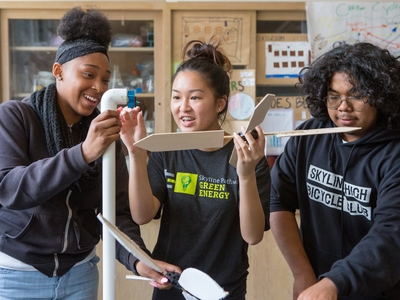New Designs for School
Self-Pacing: The Key to Differentiating Effectively for All Learners
Topics

We’ve all had the experience of truly purposeful, authentic learning and know how valuable it is. Educators are taking the best of what we know about learning, student support, effective instruction, and interpersonal skill-building to completely reimagine schools so that students experience that kind of purposeful learning all day, every day.
By restructuring our classrooms to transfer ownership from the teacher to the learner, we discovered that the most effective method to differentiate was clear: self-pacing.
Developing an effective way to differentiate instruction to reach learners with vastly different abilities has always felt like finding the Holy Grail of teaching: administrators talked about it, teachers searched for it, and yet no one could really explain how to do it. In most classrooms, teachers deal with truancy, learning disabilities, social-emotional issues, and students who are both years behind and years ahead of grade level—all at the same time. The task can feel unconquerable. By restructuring our classrooms to transfer ownership from the teacher to the learner, we discovered that the most effective method to differentiate was clear: self-pacing.
The Challenge with Differentiation
In a traditional classroom setting, differentiation is generally thought of as a tool for students with special needs—such as IEPs or 504 plans—and is carried out through lowered expectations for content mastery. A student with an intellectual disability might receive assignments that are ‘scaffolded,’ or modified downwards in terms of difficulty; allowing them to keep pace with the rest of the class by undertaking a reduced amount of learning. Because they need more time to learn, they are given fewer tasks and learn less as a result. Over time, these students progress through an age-based academic system at the same rate as their peers, and the gaps in their understanding continue to grow.
At the other end of the spectrum, high-flying students who can advance much faster than their peers rarely receive the same level of attention or opportunities for meaningful extension. They are often asked to help teach slower-moving peers (which they may or may not want or be able to do) or are given additional busywork for practice (which they do not need). Creating meaningful assignments for these students takes time and energy, which for a teacher is always in limited supply. In a mixed-ability class where the focus is on getting every student to a base level of proficiency, these talented students inevitably get lost. As a result, they stagnate.
Keep the Rigor, Change the Pace
In a self-paced classroom, differentiation occurs in terms of time and support rather than content. Students have the chance to learn in individualized ways. Some learn quickly, while others need more time. Some of them prefer group work, while others like independence. And some students require the support of an adult, while others prefer to figure things out on their own. What varies is the time that students have to complete their work and the amount of support they need in the process. What does not change substantially is the rigor of assignments students are expected to learn.
Of course, in a world where students are expected to keep pace with top-down pacing guides and are not able to consistently access learning resources from home, it is not always possible to give them unlimited time. Therefore, in certain circumstances, a teacher in a self-paced class needs to make tough decisions about priorities. They must determine which lessons are essential, which are recommendations, and which are cool extensions for students who want to push further. We like to classify lessons in three ways:
- Must Do: These are the lessons that every student is required to do. They cover the most important skills and content that are necessary for the end-of-unit assessments. Mastering these lessons is non-negotiable.
- Should Do: These are lessons which, while not essential to the learning goals of a unit, are nevertheless highly useful for students. They give students valuable opportunities to develop their skills or knowledge, and students who do complete these lessons will inevitably produce more refined work on final projects or assessments. However, when circumstances dictate, students can complete their end-of-unit assessments without mastering them.
- Aspire to Do: These assignments take the skills that students have learned in "Must Do" and "Should Do" lessons and apply them in the most sophisticated and interesting ways. Students who complete these lessons will surely produce the highest-quality work products. Every student should aspire to reach these lessons—but some simply may not. This situation is acceptable, but not ideal.
It is a far-from-perfect system, but for the time being our classrooms operate in a world of deadlines and constraints. Systems like this one make reasonable concessions to those constraints without lowering expectations for the level of mastery that students are expected to achieve. Unlike traditional methods of differentiation, self-pacing gives every student, regardless of his or her limitations, the chance to authentically master rigorous content.




